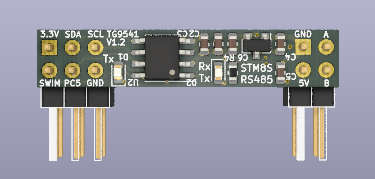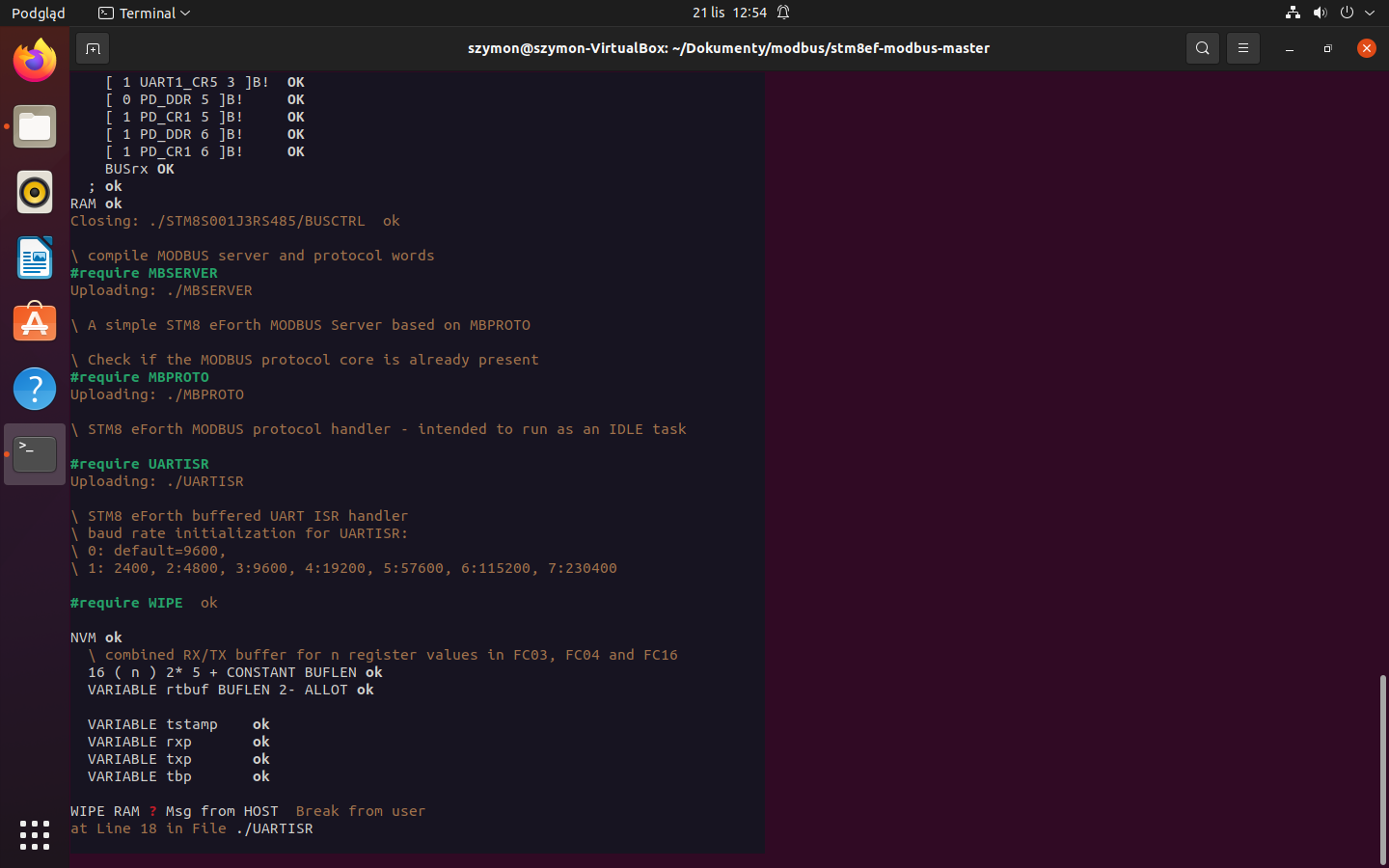This repository provides a lightweight MODBUS-RTU implementation based on STM8 eForth for, e.g., lab or home automation. It targets low-cost STM8S 8bit µCs like the STM8S003F3P6 with 8K Flash and 1K RAM which powers certain budget relay boards. With minor adaptations the code can be used for any STM8 µC.
Using STM8 Forth for MODBUS has advantages over C or assembler implementations. It's not just very compact but it also gives applications access to nifty features like "background I/O-logic" or a CLI (command line interface) for interactive testing. For simple applications it can even take the role of a MODBUS-RTU client (or "automation controller").
The CLI is, in fact, a Forth compiler/interpreter that's at the same time the operating system of the MODBUS node. It's even possible to change code while MODBUS communication is active.
The MODBUS-RTU implementation covers basic MODBUS FCs, i.e., a subset of MODBUS V1.1b commonly used for simple I/O nodes. It's easy to strip the MODBUS server down to a smaller set of FCs, or implement other FCs in a range of FC1 to FC24. It's also easy to implement "local logic" for robust, reactive and resilient automation (i.e., more than what's possible with a central controller and "dumb nodes").
In the Forth2020 #24 June 2022 User-Group meeting, the author held a talk "A Modular MODBUS Server With STM8 eForth". In the video general ideas about the architecture are explained and an example for interactive feature development and testing is given.
Code used in the demo, and further instructions, are in this GitHub Gist.
This project provides a binary release. This means that a cheap ST-Link dongle for programming the STM8 chip is all you need to use it. The volatile release contains the latest (unstable) development binary.
The MODBUS I/O Node implementation for the low-cost C0135 4-Relay RTU module is the default target. It also serves as a demonstrator. In GitHub Releases you'll find the ready-to-use binary (out/C0135/C135-forth.ihx in stm8ef-bin.zip).
You can simply transfer the ready-made binary to your board with a cheap "ST-LINK V2" dongle, or run make to flash the STM8 eForth C0135 code. After flashing you need to hold the board key S2 (the one next to the power connector) while pressing the reset key S1. The LED next to S1 flashing confirms that the Node-ID is now 1 and the baud rate 9600 baud.
After that you should be ready to test the MODBUS connection (here is an example using QModMaster:
This project doesn't just provide a better MODBUS RTU firmware for the relay board but it also turns it into something more: using a diode and a cheap USB-TTL dongle you can get a console. This means the MODBUS node is a computer, a bit like the console of a VIC20 in the old days.
Using the Forth programming language and the STM8 eForth Background Task it's easy to program local control features, e.g. a window blinds controller that reacts on local inputs without noticable lag and that communicates with a home-automation controller through "holding" registers. This way robust and safe home-automation is easier to achieve.
The STM8S001J3RS485 board is a tiny MODBUS node based on the STM8S001J3M3 "Low Density Value Line" STM8S µC in a SO8 package.
The code can be built and transferred to the devide by running make -f forth.mk BOARD=STM8S001J3RS485 flash. After flashing, the BUSCTRL file in the board configuration folder should be transferred using e4thcom and a 2-wire connection through PC5. After that, STM8S001J3RS485/board.fs can be transferred with #include.
It's easy to build custom targets, e.g. using the $0.80 MINDEV board, a cheap relay board, and an RS485 break-out board.
When using PB5 for RS485 direction control (-> BUSCTRL) the C0135 binary can be used right away (refer to the C0135 STM8 eForth Wiki page).
MBSERVER contains MODBUS function plug-ins with the following function codes (FC):
| FC | Description | Support |
|---|---|---|
| 1 | Read Coils | implemented |
| 2 | Read Discrete Inputs | implemented |
| 3 | Read Holding Registers | implemented |
| 4 | Read Input Registers | implemented |
| 5 | Write Single Coil | implemented |
| 6 | Write Single (Holding) Register | implemented |
| 15 | Write Multiple Coils | implemented |
| 16 | Write Multiple Registers | implemented |
Other FCs can be added (e.g., FC22 .. FC24).
A ready-to-use implementation for the C0135 relay board is implemented in C0135/board.fs. An example that shows how to develop minimal servers with FC handlers from scratch using the Forth console is in main.fs and, for different FCs, in the folder test.
Note that there is an experimental mapping of holding registers: holding register addresses from 60000 are mapped to the EEPROM. The mapping can be changed in the future. Community input on how to deal with MODBUS style register mapping is welcome.
For FC03, FC06 and FC15 the MODBUS address mapping is as follows:
| MB address | register MODBUS | Forth |
|---|---|---|
| 0 | holding 1 | holding |
| 1 .. 59999 | holding 2 | holding 2+ |
| 60000 | node ID | $4000 |
| 60001 | baud rate | $4002 |
| 60002 .. 60319 | user EEPROM | $4004 - $43FE STM8S EEPROM |
You can either use the binary release or build your own binary. This project uses the STM8 eForth "Modular Build" feature: make depend fetches the STM8 eForth release defined in the Makefile.
On a Linux system common dependencies are e.g. GAWK, MAKE and Python. SDCC needs to be installed. It's also possible to use tg9541/docker-sdcc in a Docker container (see details in the GitHub build workflow or refer to the Installation Instructions in the STM8EF-MODBUS Wiki).
The Getting Started section in the STM8 eForth Wiki provides an introduction to flashing STM8 eForth to a target µC.
The STM8S UART is used by UARTISR for MODBUS RTU communication. The Forth console communicates through a half-duplex simulated RS232 two-wire interface on the PD1/SWIM GPIO pin. For communication with a standard USB-TTL converter only a diode is needed. Other CLI communication options are easy to implment, e.g. using simulated full-duplex RxD-TxD lines (e.g. using PA1 and PA2 after removing the C0135 8MHz crystal). It's also possible to use an STM8S High Density device with two UARTs, e.g. the STM8S207RBT6.
Please refer to the STM8 eForth Wiki to learn more about half-duplex CLI communication options and preferred terminal programs.
The software architecture separates hardware abstraction and application in simple layers:
| Layer | Source file | Description |
|---|---|---|
| 6 | main.fs or {BOARD}/board.fs |
configuration and application layer |
| 5 | MBSERVER |
MODBUS FC plug-ins (optional) |
| 4 | MBPROTO |
MODBUS protocol layer |
| 3 | UARTISR |
buffered UART communication |
| 2 | BUSCTRL |
bus access (i.e. RS485 direction control) |
| 1 | STM8 eForth | lightweight interactive multi-tasking OS |
The different concerns are separeted in the code and FC handlers can be changed through the CLI without restarting the application!
The code is organized in the following execution domains:
- interrupt service routines for buffered MODBUS communication
- fixed-rate background task for I/O logic (asynchronous to MODBUS)
- foreground "idle mode" MODBUS protocol handler
- foreground command line interface (CLI) through independent COM port provided by STM8 eForth
- handlers for MODBUS I/O:
mbprefor input,mbactfor output actions
Please refer to the how-to in the wiki and don't hesitate to open an issue if you have questions!










